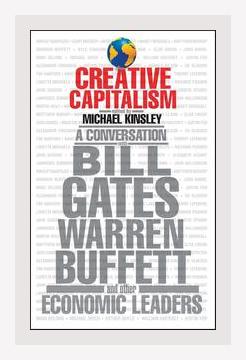Business Law and EthicsCorporate Social Responsibility
Summary of Creative Capitalism: A Conversation with Bill Gates, Warren Buffett, and Other Economic Leaders
Introduction:
“Creative Capitalism: A Conversation with Bill Gates, Warren Buffett, and Other Economic Leaders” is a book that delves into the concept of harnessing the power of capitalism to address social issues. Edited by Michael Kinsley and Conor Clarke, the book is structured around a series of essays and dialogues from influential economic leaders, primarily focused on corporate social responsibility (CSR). Notable contributors include Bill Gates and Warren Buffett, who share their insights on how businesses can align profit motives with social good.
Chapter 1: The Concept of Creative Capitalism
Key Points and Examples:
Bill Gates introduces the idea of “creative capitalism,” describing it as a form of capitalism that serves society at large. Gates argues that traditional capitalism often overlooks the needs of the world’s poorest populations.
- Example 1: Gates explains how pharmaceutical companies can focus on developing medicines for diseases prevalent in low-income countries, even if these ventures are not immediately profitable.
Action Steps:
1. Businesses can adopt a dual-motive framework, aiming for both financial returns and social impact.
2. Corporations can invest part of their R&D budget in projects that have a high potential social value, even if the financial return is lower.
Chapter 2: The Role of Business in Society
Key Points and Examples:
Warren Buffett discusses the role of large corporations in societal development and the importance of ethical business practices. He emphasizes that businesses should go beyond regulatory requirements and actively contribute to solving social issues.
- Example 2: He highlights how Berkshire Hathaway has invested in environmentally friendly technologies, aligning long-term business interests with public welfare.
Action Steps:
1. Implement environmentally sustainable practices in business operations.
2. Develop corporate policies that prioritize long-term social and environmental benefits.
Chapter 3: Corporate Responsibility and Profitability
Key Points and Examples:
Several essays in this chapter argue that CSR initiatives can be profitable in the long run. They suggest that businesses that actively engage in CSR can create brand loyalty and a competitive advantage.
- Example 3: Starbucks offers fair trade coffee, which, while slightly more expensive, attracts customers who are willing to pay a premium for ethical products.
Action Steps:
1. Identify CSR initiatives that resonate with your customer base.
2. Promote transparency in sourcing and production processes to build trust and loyalty.
Chapter 4: Innovative CSR Models
Key Points and Examples:
This chapter discusses various innovative CSR models that companies have implemented around the world. These models often involve partnerships between businesses, NGOs, and governments.
- Example 4: The Global Alliance for Vaccines and Immunization (GAVI) is highlighted as a successful model where pharmaceutical companies, NGOs, and governments collaborate to improve global health.
Action Steps:
1. Engage in multi-stakeholder partnerships to tackle complex social issues.
2. Allocate resources for collaborative projects that have scalable social impact.
Chapter 5: Challenges and Criticisms of Creative Capitalism
Key Points and Examples:
The book also addresses the challenges and criticisms of creative capitalism. Some argue that profit motives can conflict with social objectives, leading to superficial CSR efforts or “greenwashing.”
- Example 5: The backlash against some “eco-friendly” product lines that failed to live up to their environmental claims is discussed as a cautionary tale.
Action Steps:
1. Ensure that CSR initiatives are genuine and have measurable social impact.
2. Avoid overpromising and underdelivering on CSR commitments.
Chapter 6: Measuring Social Impact
Key Points and Examples:
Accurate measurement of social impact is crucial for the success of CSR initiatives. This chapter discusses various methodologies for measuring social impact, including both quantitative and qualitative metrics.
- Example 6: The use of the Social Return on Investment (SROI) metric to evaluate the societal benefits relative to the costs of CSR projects.
Action Steps:
1. Adopt robust metrics to measure the effectiveness of CSR efforts.
2. Regularly report on social impact to stakeholders to maintain accountability.
Chapter 7: The Future of Corporate Social Responsibility
Key Points and Examples:
The contributors speculate on the future of CSR and creative capitalism. They propose that as global challenges like climate change and poverty become more pressing, the role of businesses in addressing these issues will only grow.
- Example 7: The increasing trend of impact investing, where investors seek to generate social or environmental benefits alongside financial returns, is discussed as a sign of evolving corporate responsibility.
Action Steps:
1. Stay abreast of emerging trends in CSR and impact investing.
2. Continuously innovate and adapt CSR strategies to align with evolving global challenges.
Conclusion: Collective Responsibility and Action
Key Points and Examples:
The final section underscores the collective responsibility of businesses, governments, and individuals in fostering a more equitable and sustainable world.
- Example 8: The success of initiatives like the UN Global Compact, where companies commit to sustainable and socially responsible policies, is highlighted as an example of collective action.
Action Steps:
1. Commit to global initiatives that promote sustainability and social responsibility.
2. Encourage collaboration and dialogue among various sectors to address complex global issues effectively.
Final Thoughts:
“Creative Capitalism” serves as both a critique and a roadmap. The contributors present a compelling case for why and how businesses can, and should, contribute to social good while also profiting. The diverse perspectives provide a comprehensive view of the possibilities and challenges of integrating CSR into business models. Reading this book and implementing its recommendations can serve as a powerful impetus for companies and individuals looking to make a meaningful impact.
By following the specific actions suggested, businesses and individuals alike can take significant steps toward creating a more just and sustainable future, aligning capitalist endeavors with the greater good.
